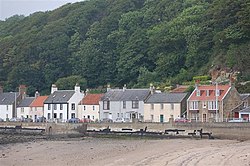Limekilns
| Limekilns | |
| Fife | |
|---|---|
 Houses along the shore at Limekilns | |
| Location | |
| Grid reference: | NT079832 |
| Location: | 56°1’58"N, 3°28’46"W |
| Data | |
| Post town: | Dunfermline |
| Postcode: | KY11 |
| Dialling code: | 01383 |
| Local Government | |
| Council: | Fife |
| Parliamentary constituency: |
Dunfermline & West Fife |
Limekilns is a pretty, little village in Fife, on the shore of the Firth of Forth, around three miles south of Dunfermline. It is a quiet fishing village today, but behind its current quiet charm it has a history as an industrial centre and port, whence it received its name, from the kilns here which baked limestone into lime, belching their fumes across the bay as in so many other coastal villages of the time.
History and economy
Unlike the neighbouring village of Charlestown, Limekilns is an old settlement dating back to the 14th century. In its early days Limekilns was mainly a fishing village, with the large natural harbour, sheltered by the rocky ridge known as The Ghauts, providing docking facilities for small to medium transport and cargo ships. From here ships traded with the ports in the Baltic Sea and France until the seventeenth century. In the early 14th century there was a port for the town of Dunfermline, called Galletts, at the site of the current settlement of Limekilns, this served as the principal port for the town which lies a few miles inland.[1]
The importance of the local limestone became clear quite early in the village's history, being used both as a fertiliser and for the manufacture of mortar used in the construction stone buildings. Workings using kilns fuelled by charcoal and later coal to convert lime to quicklime grew up, the product being exported from the port along the east coast of Scotland. Today the only tangible legacy of this industry in village is the name Limekilns. In the 1750s the lime industry transferred a mile or so west along the coast to Charlestown, where the ruins of the massive kilns still exist today.[2]
For many centuries Limekilns was also the northern terminus for a ferry linking it to Bo'ness on the southern side of the Forth. This found an echo in Robert Louis Stevenson's Kidnapped: it was from Limekilns that David Balfour and Alan Breck were carried across the Forth in a rowing boat.
Soap was also produced from a soapworks located near Caupernaum Pier. The 'Soap Sheds' still exist and are used as storage facilities. The years of industrial decline meant that most of these industries were lost and Limekilns became just another sleepy coastal village. New housing estates were added during the property boom of the 1970s and 1980s, considerably boosting the size and population of the village.[1]
Landmarks
Limekilns sits within the lands which traditionally belonged to the Earl of Elgin of Broomhall House, which overlooks the village.[3]
The oldest building in the village is The King's Cellar, a large property which can be traced back to 1362. It has served many different purposes throughout its long life, notably as a store house, school, library and chapel. It is currently employed as a Freemasons' Lodge and is generally not open to the public.[4]
The village has a range of amenities including a primary school,[5] doctor's surgery,[6] shops and a Sea Scout Group[7] as well as a Guide unit. The Ship Inn is said to be the 'watering hole' featured in Robert Louis Stevenson's novel Kidnapped.[8]
Transport
The Earls of Elgin owned land in the Crossford area in connection with the Elgin Colliery (at Parkneuk and Baldridge Burn, north-west of Dunfermline) and the Elgin Railway that ran from the Colliery round Crossford and then down beside Waggon Road and on to Charlestown harbour. The route of the railway and the site of the Elgin Colliery are shown in a map in Chalmers' book, Historical and Statistical Account of Dunfermline.[9]
To the north, paths run via Pitliver to Crossford and through the estate of the Earl of Elgin and Wester Gellet to Pittencrieff Park at Dunfermline.[10]
| ("Wikimedia Commons" has material about Limekilns) |
References
- ↑ 1.0 1.1 "Limekilns". Undiscovered Scotland. https://www.undiscoveredscotland.co.uk/limekilns/limekilns/index.html. Retrieved 3 March 2020.
- ↑ "The Charlestown Limekilns". Inner Forth Landscapes. https://www.innerforthlandscape.co.uk/projects/conserving-restoring/charlestown-limekilns. Retrieved 3 March 2020.
- ↑ "Broomhall Our Home". Broomhall House. https://www.broomhallhouse.com/our-home/. Retrieved 3 March 2020.
- ↑ "Elgin & Bruce Lodge No 1077 History of the King's Cellar". Elgin and Bruce Lodge 1077. http://www.lodgeelginandbruce1077.co.uk/history-of-the-kings-cellar/4582802180. Retrieved 3 March 2020.
- ↑ "Limekilns Primary School". Fife Council. https://www.fife.gov.uk/facilities/primary-school/limekilns-primary-school. Retrieved 3 March 2020.
- ↑ "Limekilns Surgery". https://limekilns.cylex-uk.co.uk/company/limekilns-surgery-18681071.html. Retrieved 3 March 2020.
- ↑ "81st Fife Sea Scout Group". 81st Fife Sea Scout Group. http://81stfifescouts.org.uk/. Retrieved 3 March 2020.
- ↑ "The Ship Inn". Visit Scotland. https://www.visitscotland.com/info/food-drink/the-ship-inn-p1864921. Retrieved 3 March 2020.
- ↑ Rev. Peter Chalmers (1846). Historical and Statistical Account of Dunfermline. William Blackwood and Sons, Edinburgh. Plate=I
- ↑ "Dunfermline Village Loop". Walk Fife. http://www.walkfife.com/maps-routes/dunfermline-village-loop/. Retrieved 3 March 2020.
